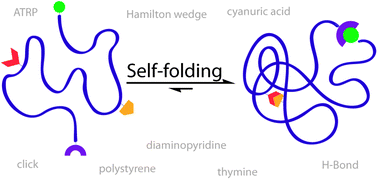Bioinspired dual self-folding of single polymer chains via reversible hydrogen bonding†
Abstract
With the long term aim of preparing synthetic

* Corresponding authors
a
Preparative Macromolecular Chemistry, Institut für Technische Chemie und Polymerchemie, Karlsruhe Institute of Technology (KIT), Engesserstr. 18, Karlsruhe, Germany
E-mail:
christopher.barner-kowollik@kit.edu
Web: www.macroarc.de
b Soft Matter Synthesis Laboratory, Institut für Biologische Grenzflächen I, Karlsruhe Institute of Technology (KIT), Herrmann-von-Helmholtz-Platz 1, Eggenstein-Leopoldshafen, Germany
With the long term aim of preparing synthetic

 Please wait while we load your content...
Something went wrong. Try again?
Please wait while we load your content...
Something went wrong. Try again?
O. Altintas, E. Lejeune, P. Gerstel and C. Barner-Kowollik, Polym. Chem., 2012, 3, 640 DOI: 10.1039/C1PY00392E
To request permission to reproduce material from this article, please go to the Copyright Clearance Center request page.
If you are an author contributing to an RSC publication, you do not need to request permission provided correct acknowledgement is given.
If you are the author of this article, you do not need to request permission to reproduce figures and diagrams provided correct acknowledgement is given. If you want to reproduce the whole article in a third-party publication (excluding your thesis/dissertation for which permission is not required) please go to the Copyright Clearance Center request page.
Read more about how to correctly acknowledge RSC content.
 Fetching data from CrossRef.
Fetching data from CrossRef.
This may take some time to load.
Loading related content
